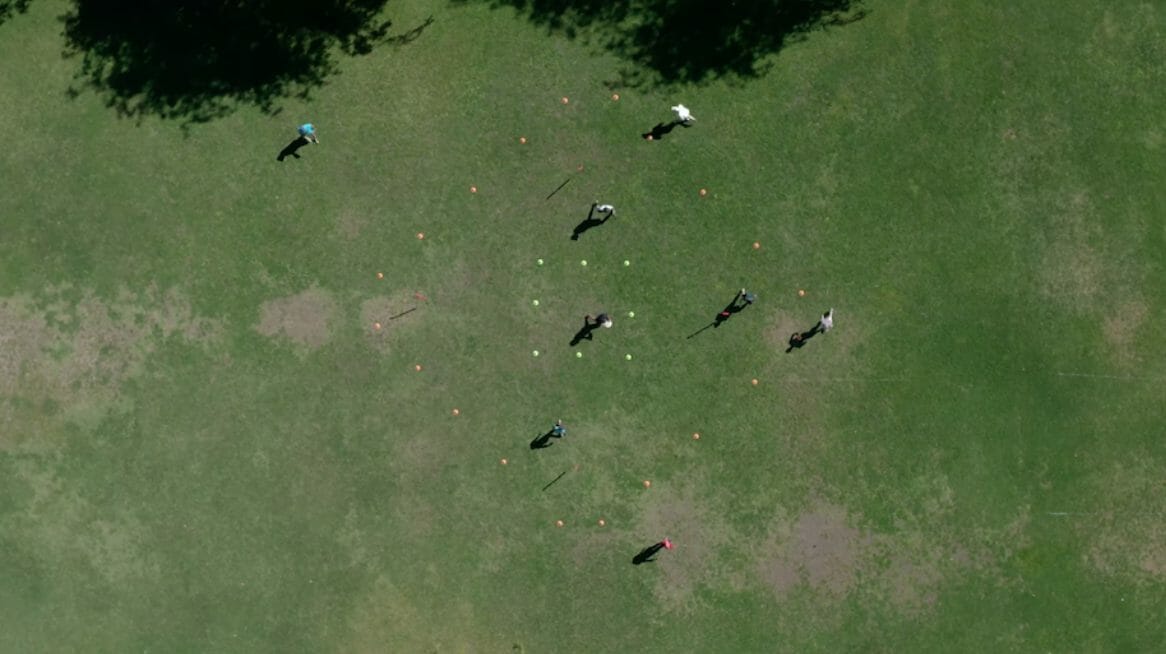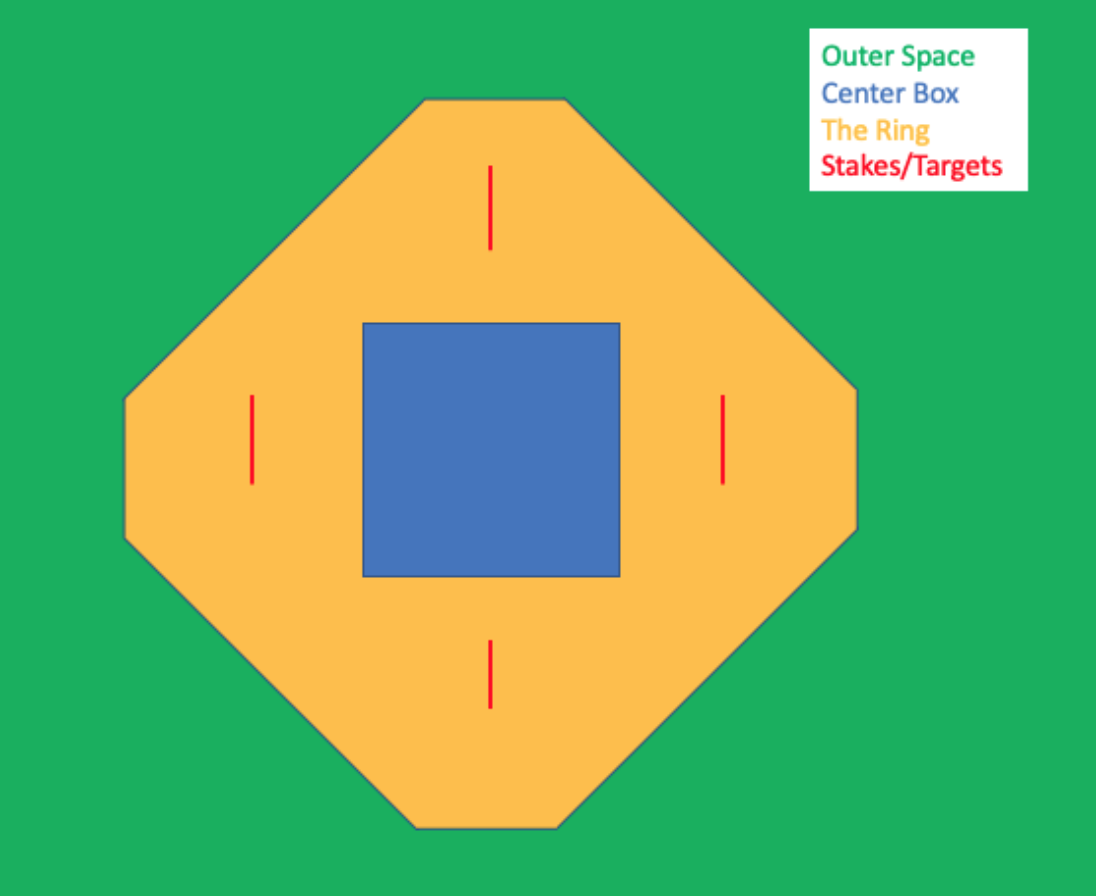Another socially distanced disc game.
March 30, 2021 by Guest Author in Other with 0 comments

Tuesday Tips are presented by Spin Ultimate; all opinions are those of the author. Please support the brands that make Ultiworld possible and shop at Spin Ultimate!
This article was written by Louis Gosart, a chief organizer in the LA Throwback Foundation and a coach of the Santa Monica High School Stingrays. He grew up in Los Angeles and has been playing ultimate for over five years. Louis is currently seeking a business economics degree at UCLA. You can reach him at [email protected].
Octimate is a socially-distanced disc game originally cultivated by me and members of the LA Throwback Foundation as part of an initiative to provide safe ways to play ultimate during the pandemic. However, to come up with some new games, I first had to understand what makes ultimate risky to play during a pandemic.
To me, the two most dangerous aspects of COVID-era ultimate are marking, which creates a constant lack of social distancing, and the shared disc, which can come into contact with up to 14 players per point. Limiting the shared object aspect is easy to fix by coming up with a game that requires less players per team and restricts each team to using their own disc. However, eliminating marking provides a much more challenging problem. Marking is inherent in ultimate, because you must throw the disc to a person to score and marking helps the defense prevent that. Therefore, to eliminate marking, the scoring method must be changed.
I took inspiration from small player games like Hot Box and Boot. The great thing about Boot, in particular, is that in order to score, the offense must hit a cone, making the game partially distanced due to the defense poaching the cones vs. guarding a player. But the problem with all these games is that both the offense and the defense are open to roam the entire field, and because of that, marking inevitably happens. I realized the only way to fix the marking problem is to physically separate the offense and the defense. This was the birth of Octimate.
RELATED: How Ultimate Can Return to Play
With a combination of target-scoring and the Hot Box field design, I created the first Octimate prototype. Originally, the field was exactly like a Hot Box court, with four targets (represented by garden stakes) in each corner of the “center ring” (see map below). There were also only three offensive players, one in the center box and two on the outside. Thanks to some of my former youth teammates on Santa Monica’s Riptide, who were willing to trial-run the game with me, we managed to create a playable version.
At the time, I reached out to Robbie Adler, who runs a Sunday morning pickup game in Culver City (and is possibly the kindest human in the world). I wanted to introduce this game to the local community. The Sunday group had been throwing and playing distanced games like double disc court, and Robbie agreed to have me introduce the game. We started playing last November. However, due to the California stay-at-home order over the winter, we cancelled playing until mid-February, when it was safer to begin again. As the game has been played more and more, I have changed or adjusted the rules slightly many times based on feedback I received from players. But you’re probably wondering at this point, what is this game all about?
Rules
Octimate is a 4v4 player game where the goal for the offense is to hit the targets, represented by stakes/posts, with the disc to score. The defense tries to defend the stakes to prevent the offense from scoring. Basic ultimate rules still apply: if the disc hits the ground it’s a turnover, the player with the disc can only pivot and cannot travel, and both teams play to a predetermined score (games can be anywhere from 3-11 points to win).
The field is structured as follows:

On the field of play, there are four offenders: one offender in the center box, known as the “center,” and three outside the octagon in the outer space. Of the four defenders: three are restricted to the ring between the center box and the perimeter of the octagon. There is one defender off the field, actively keeping the stall count and calling fouls. Each player must stay within their restricted zone throughout the entirety of a possession, until the disc is turned over. Each team has their own disc for play and keeps track of it via the center/off-field defender. A possession starts with the center ensuring that the defense is set and then tapping the disc in. The first throw cannot be a score.
The Stall
There are two different stall counts, enforced by the off-field defender. A stall of four is enforced on the center, while a continuous stall of 12 is enforced on the outer offense. In other words, the outer offense has 12 seconds to return the disc to the center or score via a “corner” or “cross-court” shot (i.e. an outer offender shoots, scores, and completes a pass to another outer offender). A “corner” or “cross-court” shot also resets the 12 stall.
Strategy
The offense generally tries to maximize the amount of scores per possession. Contrary to ultimate, where you can only score once per possession, the rule in Octimate is that if a throw hits/grazes a stake, and the pass is still completed, the score counts AND the offense maintains possession of the disc. We call this a continuation. So, in theory, the offense can win the game on just one possession. To strategize for this, when an offender throws the disc to hit a stake, ideally there should be another offender moving to the space behind that stake ready to catch the disc. This opens the door to a variety of strategic decisions. An outer offender with the disc can try to reset the stall-count with an over-the-top throw to the center, or they can potentially try for a corner shot to another outer offender. These decisions depend on the throwing skills and communication of the offense, as well as the way the defense is set.
Defensive strategy typically involves a combination of “match” and “zone” defense. The defense wants to prevent a score by guarding the stakes, while also preventing open passes to the center. When the disc is tapped in, the defense tries to prevent an easy first pass out from the center. Once the first throw is made, defenders often move to the disc-side of the ring to try to cover the two stakes nearest to the thrower, as well as the easy centering pass. This defensive structure looks similar to a loose zone-like cup. There are a number of iterations of this resulting “zone” defense that are situationally based; however, if the disc is re-centered, the defense often switches back to matchup-like defense to try to prevent an open continuation shot.
There are strict rules for pivoting and straddling to keep the offense/defense in their respective zones. If a rule of this nature is broken, the offense/defense can call a foul, and the procedure works similarly to the way it does in regular ultimate. To see a breakdown of these rules and the possible cases, as well as a breakdown of how to build the targets and set up the field, refer to the extended version of the rules (Basic Rules / Extended Rules). Here is some footage of the game in action:
The really cool thing about this game is that it has the potential to provide an alternative to regular ultimate, even in non-pandemic times (much like Goaltimate or Hot Box). What started as just an idea to play ultimate safely has manifested itself into a game with actual complex strategy and its own unique appeal. Obviously, once it’s safe to play ultimate again, everyone, myself included, will gravitate back to the sport we all know and love. But over the past few months, our community has grown attached to this game, and I don’t see it going away at the end of the pandemic. I really hope that you try playing Octimate in your community, if not during the close of this pandemic then for the sake of trying something new.
Special thanks to Luke Hart-Moynihan and Robbie Adler for helping create this game and for editing the rules. Also, thanks to LA Throwback for purchasing the equipment.
For more anti-COVID disc games, check out Covidimate and Space Disc.